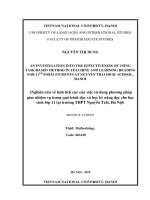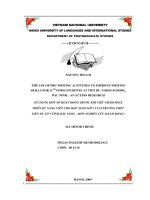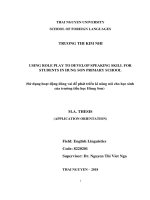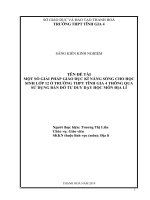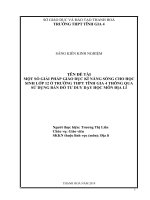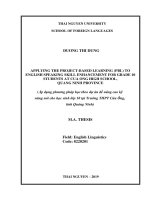Hiệu quả của việc sử dụng giáo cụ trực quan để phát triển kỹ năng nói cho học sinh lớp 12 tại trường THPT cẩm phả
Bạn đang xem bản rút gọn của tài liệu. Xem và tải ngay bản đầy đủ của tài liệu tại đây (1.05 MB, 94 trang )
THAI NGUYEN UNIVERSITY
SCHOOL OF FOREIGN LANGUAGES
NGUYEN THI DUONG
THE EFFECTIVENESS OF USING VISUAL AIDS TO PROMOTE
SPEAKING SKILLS FOR THE 12TH GRADERS
AT CAM PHA HIGH SCHOOL
(Hiệu quả của việc sử dụng giáo cụ trực quan để phát triển kỹ năng nói cho
học sinh lớp 12 tại trường THPT Cẩm Phả)
M.A. THESIS
Field: English Linguistics
Code: 8220201
THAI NGUYEN – 2019
THAI NGUYEN UNIVERSITY
SCHOOL OF FOREIGN LANGUAGES
NGUYEN THI DUONG
THE EFFECTIVENESS OF USING VISUAL AIDS TO PROMOTE
SPEAKING SKILLS FOR THE 12TH GRADERS
AT CAM PHA HIGH SCHOOL
(Hiệu quả của việc sử dụng giáo cụ trực quan để phát triển kỹ năng nói
cho học sinh lớp 12 tại trường THPT Cẩm Phả)
M.A. THESIS (APPLICATION
ORIENTATION)
Field: English Linguistics
Code: 8220201
Supervisor : Dr. Nguyen Thi Huong
THAI NGUYEN – 2019
DECLARATION
I hereby certify that no part of the thesis has been copied or reproduced by me from
any other person’s work without acknowledgement and that the thesis is originally
written by me under strict guidance of my supervisor.
Quang Ninh, September 20th 2019
Trainee
Nguyen Thi Duong
This study was approved by
i
ACKNOWLEDGEMENTS
The thesis could not have been completed without the help of many people to
whom I am indebted.
First of all, I am greatly indebted to Dr. Nguyen Thi Huong, my supervisor,
for her invaluable guidance, comments, criticisms, corrections and for her kindly
constant encouragement during the course of writing this thesis.
Second, I would like to thank all lecturers at Foreign Languages Department,
Thai Nguyen University for their valuable teaching and tremendous assistance that
have enlightened my study path.
Third, I am grateful to my colleagues at Cam Pha high school for their
constructive suggestions about this research. Without their help and cooperation, the
research would have been made impossible.
I also would like to give my special thanks to the students at Cam Pha high
school who have actively participated in my study.
Last but not least, my sincere thanks go to my family, my classmates at the
Master Course Class, my friends, especially my husband, who also encourages and
shares the hardship with me.
These people deserve all the credit. I highly appreciate all their support and
contribution.
Nguyen Thi Duong
ii
ABSTRACT
This study is an attempt to investigate the use of visual aids in teaching
speaking to 12 graders at Cam Pha high school. The main purposes of the study are
to find out: the current English speaking teaching and learning situation at Cam Pha
high school; activities and techniques of teaching with visual aids applied by
teachers and students’ preferences; the difficulties in learning and teaching English
speaking and then give some suggestions for teachers to stimulate students in
speaking and overcome the difficulties they have to face with in teaching speaking
English for students. The study adopts action research approach, with the use of
mixed research methods involving both qualitative and quantitative data. Two
hundred 12th grade students and four teachers took part in the study. The findings
show that the use of visual aids significantly enhanced students’ interest and
engagement in speaking skills. Students also reported their improvement in various
aspects of speaking skills. The study proposes implications and suggestions for
using visual aids in improving speaking skills.
3
TABLE OF CONTENTS............................................................................................
DECLERATION .........................................................................................................i
ACKNOWLEDGEMENT ..........................................................................................ii
ABSTRACT .................................................................................................................iii
TABLE OF CONTENTS............................................................................................iv
CHAPTER 1: INTRODUCTION............................................................................ 1
1.1
Rationale of the study ....................................................................................... 1
1.2
Aims and objectives of the study ...................................................................... 2
1.3. Research questions ............................................................................................... 2
1.4. Scope of the study ................................................................................................ 2
1.5. Significance of the study ...................................................................................... 3
1.6. Design of the study ........................................................................................4
CHAPTER 2: LITERATURE REVIEW................................................................ 5
2.1
Speaking skills .................................................................................................. 5
2.1.1 Mỉco and macro skills of speaking .............................................................. 6
2.1.2
2.2
Fluency and accuracy ................................................................................. 7
Teaching speaking............................................................................................. 7
2.2.1
Teaching and learning speaking skills ....................................................... 7
2.2.2
Principles for designing speaking techniques ............................................ 8
2.2.3
Problems in learning speaking ................................................................... 9
2.3 Visual aids ........................................................................................................... 10
2.4 Roles and functions of visual aids in language teaching and learning ............... 14
2.5 Use of visual aids in language teaching and learning ......................................... 15
2.6. Previous studies.................................................................................................. 17
4
2.7. Summary ........................................................................................................... 18
CHAPTER 3: METHODOLOGY......................................................................... 19
3.1
Research method ............................................................................................. 19
3.2
Research design............................................................................................... 20
3.2.1.Students ........................................................................................................ 23
3.2.2. Teachers ...................................................................................................... 23
3.2.3. Research procedure ..................................................................................... 24
3.3. Data collection instruments................................................................................ 27
3.3.1. Questionnaire .............................................................................................. 27
3.3.2. Observation ................................................................................................. 28
3.3.3.Interviews ..................................................................................................... 30
3.4. Data analysis ...................................................................................................... 30
3.5. Validity and reliability ....................................................................................... 32
CHAPTER 4: FINDINGS AND DISCUSSIONS ................................................. 34
Questionnaires........................................................................................................... 34
4.1.1.The reality of the current learning speaking English .................................. 34
4.1.1.1. Students’ purposes of learning speaking English ................................ 34
4.1.1.2.Students’ assessment on the importance of speaking English .............. 35
4.1.1.3 students' opinions towards speaking activities...................................... 35
4.1.1.4. Students’ frequency of speaking English in speaking class ................. 36
4.1.1.5 Causes of students' reluctance to speak in class.................................... 37
4.1.2 Students' attitudes towards using visual aids in the speaking lesson ............... 38
4.1.3 Teachers' attitudes towards using visual aids in speaking lesson .................. 42
4.2.
Observations.................................................................................................... 45
5
4.3.Interviews ............................................................................................................ 46
CHAPTER 5: CONCLUSION............................................................................... 49
5.1. Concluding remarks ........................................................................................... 49
5.2. Limitations ......................................................................................................... 50
5.3. Implications........................................................................................................ 50
5.4 . Suggestions to further studies ........................................................................... 51
REFERENCES ........................................................................................................ 53
APPENDICES .............................................................................................................I
6
CHAPTER 1: INTRODUCTION
1.1
Rationale of the study
Nowadays, English has an important role in the world. Most countries in the
world use English as medium of communication in many aspects of life. Meanwhile,
in Vietnam, English is considered as a foreign language. It also has been introduced
to educational institutions, which is learnt from Junior High School up to university
as a compulsory subject.
Oral communication competence or speaking skills is the goal of English
learning in many schools. Speaking skill is considered as an initial skill that leads
learners to develop the other communication competences (reading and writing).
However, it is assumed that developing speaking skill to 12th graders in our school
is not easy because of the status of English as a foreign language in which it is not
used in national or social life.
With more than 8 years of experience in teaching English at Cam Pha high
school, the researcher find that students have to learn English in 2 semesters in the
curriculum. At the end of each semester, the students have to take a written tests and
spoken tests. However, the result of spoken test is always lower than the one of
written test. With my own teaching experience and what I have observed from my
colleagues’ teaching, I found certain of reasons why students usually obtain
unsatisfied achievement:
1. There are plenty of different levels of ability in learning English the class
2. As soon as we put them in groups, our students speak Vietnamese not English
3. The students always make too much noise
4. We would like to do more speaking activities, but our students just won’t
co- operate
5. The students make so many mistakes that we cannot correct them
6. We do not have time to give them enough speaking practice
7. Some topics are not interesting.
Supiyati (2011) stated that practically the use of visual aids is one of the
appropriate techniques to develop students’ speaking skills. Actually, there are
many
1
kinds of visual aids that the researcher will describe like
pictures, graphics,
charts, illustrations etc. Through visual aids, the students are more enthusiastic.
Students enjoyed the process of teaching and learning more. Teaching speaking
using visual aids gives a big chance to the students to speak. Due to the identified
issues of speaking skills of high school students in Vietnam and the effects of
employment of group work on enhancing the students’ speaking skill, this research
employs the treatments of action research to conduct the research on: “The
effectiveness of using visual aids to promote speaking skill for the 12th graders at
Cam Pha high school”.
1.2 Aims and objectives of the
study
The overarching aim of this current research is to investigate the Vietnamese
high school students’ speaking behaviors and performance under the effects of
using visual aids in English speaking lessons in the context of public high school
from the perspectives of both the EFL teachers as instructors and students.
The following specific objectives will be supportive to the areas of research:
1 To find out the 12th grader’ attitudes towards using visual aids to teaching
speaking at Cam Pha high school.
2 To evaluate the effectiveness of using visual aids in teaching speaking at Cam
Pha high school.
1.3
questions
Research
Based on research objectives, there are three research questions
as
1)
How do visual aids promote speaking skills for the 12th graders at
Cam
Pha high school?
2)
What are Cam Pha high school students’ perceptions of and
attitudes
toward using visual aids in speaking lessons?
3)
What are Cam Pha high school teachers’ attitudes toward using visual
aids in speaking lessons?
2
1.4 Scope
study
of
the
The study is carried out at Cam Pha high school. This study investigated the
issues and changes that arise from an EFL speaking class. This study included 200
students of grade 12 at Cam Pha high school. Students are surveyed to find out
the
3
effectiveness of using visual aids to promote their speaking skills. Furthermore, the
researcher’s intention was to
carry out classroom observation, and interview
teachers and students to see if they workable and effective, and to make some
suggestions to help the students better their speaking skill. The report has carried out
in the first semester of academic year 2018-2019 with only 12th-grade students;
hence, the respondents does not represent for all students who study English major in
Vietnam.
1.5 .Significance
study
of
the
This current study is devoted to generate both theoretical and practical
contributions. Theoretically, although there are certain number of studies previously
conducting the investigation into the use of visual aids in the EFL context, the major
concerns of these studies lie on other aspects of English as vocabulary or listening,
not speaking skills. Particularly, in Vietnam there is a scarcity of research exploring
the implementation of visual aids in English speaking teaching and learning at
upper elementary level. There has been little evidence supporting the effectiveness
and implementation of visual aids in an English class. Therefore, the study findings
expect to fill the gap of literature in this aspect and provide valuable information for
the researchers who are interested in cooperating visual into their teaching.
Concerning the practical contributions, it is expected that the present study
may benefit teachers and students at high schools, particularly, which have problems
in instructing English speaking skills, contributing to the reform of English
curriculum design and teaching pedagogy at upper elementary level. Most of the
typical problems that the students of grade 12 face while speaking are that they
cannot speak beyond short segments because of lack of vocabulary, poor grammar
and pronunciation. Due to this problem, they cannot participate actively in
conversation and activities based on daily life situations. They have frequent
communication gaps and misunderstandings results in lack of communication
strategies therefore they speak slowly and take a lot of time to compose sentences.
All of these problems can only be solved by improving student’s speaking skills
through visual aids. In the scenario of Vietnamese public school the teachers tend to
4
see their role merely in terms of an instructor or a director. The implementation of
visual aids in English speaking classrooms enables the teacher
5
to shift their teaching approach from teacher-centered to student-centered in
alignment with the Communicative Language Teaching (CLT) which has been
promoted in English teaching in all educational levels in Vietnam.
1.6 Design
study
of
the
The study is divided into three parts: the Introduction, the Development and
the
Conclusion
chapters.
with
reference
to
five
Chapter 1: Introduction - deals with the rationale, aims, scope, methods,
significance and design of the study
Chapter 2: Literature Review- is intended to give some theoretical
background related to speaking, speaking problems, Communicative Language
Teaching (CLT), visual aids, and previous studies relating to the topic of research.
Chapter 3: Methodology- deals with research governing orientation, research
methods and presents the situation analysis, participants, data collection instruments,
data collection procedures and data analysis. The detailed results of the survey and a
comprehensive analysis on the data collected are focused.
Chapter 4: Findings and Discussions- show major findings and discussions
and offer some recommendation for teachers to motivate students to speak
and overcome some difficulties they meet in teaching speaking through the
employment of group work activities.
Chapter 5: Conclusion- is a review of the study, suggestions for
further research and limitations of the study.
6
CHAPTER 2: LITERATURE REVIEW
It is stated in the previous chapter that the purpose of this study is to improve
the students’ speaking skills by using visual aids. Thus, in this chapter, to support
this study, some theoretical descriptions on speaking and visual aids will be
described thoroughly.
2.1 . Speaking skills
There are many definitions of speaking by experts. According to Spratt,
Pulverness, and William (2011), speaking is a productive skill, like writing. It
involves using speech to express meanings to other people. When people speak, they
use different aspects of speaking depending on the type of speaking they are
involved in. That is why speaking is a complex activity.
Brown (2004) defines speaking as a productive skill that can be directly and
empirically observed. Speaking is the product of creative construction of linguistic
strings, the speaker makes choices of lexicon, structure, and discourse.
Thornburry in Harmer (2007) suggests various dimensions of different
speaking events in order to describe different speaking genres. There is a
distinctionbetween transactional and interpersonal functions. Transactional function
has its main purpose conveying information and facilitating the exchange of goods
and services, whereas the interpersonal function is all about maintaining and
sustaining good relations between people.
According to Riddell (2003), speaking is one of two things in a lesson.
Speaking is not reading aloud (pronunciation), either reading the answer to a
grammar question (accuracy). Speaking is neither reading the answer to a
reading/listening question (comprehension). In each of these cases the aims are not
speaking-related. It could be a speaking activity designed to give practice of
languagejust learned or reviewed.
From many definitions and explanations about speaking above, it can
be concluded that speaking is actually a way of how people communicate and
interact toeach other and convey the meaning they want the hearer to get.
7
2.1.1 Micro and macro skills of speaking
In teaching speaking, teachers also help students to learn micro skills and
macro skills of speaking, as stated by Brown (2004). The microskills and
macroskills of speaking are listed as follow:
Microskills
1)
Produce differences among English phonemes and allophonic
variants.
2)
lengths.
3)
Produce chunks of language of different
Produce English stress patterns, words in stressed and
unstressed positions, rhythmic structure, and intonation contours.
4)
phrases.
5)
Produce reduced forms of words and
Use an adequate number of lexical units (words) to
accomplish pragmatic purposes.
6)
delivery.
7)
Produce fluent speech at different rates of
Monitor one’s own oral production and use various strategic devices
(pauses, fillers, self-corrections, backtracking) to enhance the clarity of the
message.
8)
Use grammatical word classes (nouns, verbs, etc.), systems (e.g.,
tense, agreement, pluralization), word order, patterns, rules, and elliptical
forms.
9)
Produce speech in natural constituents: in appropriate phrases,
pause groups, breath groups, and sentence constituents.
10)
forms.
11)
Express a particular meaning in different grammatical
Use cohesive devices in spoken
discourse. Macroskills
1)
Appropriately accomplish communicative functions according
to situations, participants, and goals.
8
2)
Use appropriate styles, registers, implicature, redundancies, pragmatic
conventions, conversation rules, floor-keeping and yielding, interrupting, and
other sociolinguistic features in face-toface conversations.
9
3)
Convey links and connections between events and communicative
such relations as vocal and peripheral ideas, events and feelings,new
information and given information, generalization andexemplification.
4)
Convey facial features, kinesics, body language, and other
nonverbal cues along with verbal language.
5)
Develop and use a battery of speaking strategies, such as emphasizing
key words, rephrasing, providing a context for interpreting the meaning of
words, appealing for help, and accurately assessing how well the speakers’
interlocutor is understanding conveyed messages.
Those micro and macro skills above can be a checklist of objective when
assessing spoken language. Teachers should pay attention to these when they are
teaching speaking skills.
2.1.2 Fluency and accuracy
According to Riddell (2003), the ability to talk fairly freely, without too
much stopping or hesitating is called fluency. It requires the listener understands
what is being said, so there must be intelligibility and meaning. With accuracy the
emphasis is on “correct English” – the right grammar, the right vocabulary. Both
fluency and accuracy are equally important. But Riddell has different thought. It is
actually depends on what the teachers are teaching. If they teach a high-level student
who is about to take an exam to enter college, accuracy is very important indeed.
On the other hand, when teaching beginners, or other very low levels,
teachers cannot possibly expect fluency. Here, teachers really do have to help them
build their language accuracy bit by bit until they reach the stage when they can
speak more fluently. What is far more important is that they can make themselves
understood, and can talk relatively fluently. Teachers need to give their students
confidence when speaking and not to be obsessed with constant correction.
2.2 Teaching speaking
2.2.1 Teaching and learning speaking skills
Kimble and Garmezy in Brown (2000) state that learning is a relatively
permanent change in a behavioral tendency and is the result of reinforced practice.
While teaching
10
is showing or helping someone to learn how to do something, giving instructions,
guiding in the study of something, providing with knowledge, causing to know or
understand.
Brown (2000) breaks down the components of the definition of learning, and
extract the domains of research and inquiry: Learning is acquisition or “getting”,
learning is retention of information or skill, retention implies storage systems,
memory, and cognitive organization, learning involves active, conscious focus on
and acting upon events outside or inside the organism, learning is relatively
permanent but subject to forgetting, learning involves some form of practice,
perhaps reinforced practice and learning is a change in behavior. Brown also
cites that teaching is guiding and facilitating learning, enabling the learner to
learn, setting the conditions for learning. Regarding the definitions about teaching
and learning above, it can be concluded that both of them cannot be separated.
Teaching and learning are two processes to achieve something. It is also a process of
take and give, in this case, knowledge.
2.2.2 Principles for designing speaking techniques
According to Brown (2000), there are seven principles for designing
speaking techniques. They are stated as follows:
1) Using techniques that cover the spectrum of learner needs, for languagebased focus on accuracy to message-based focus on interaction, meaning, and
fluency;
2) Providing intrinsically motivating techniques;
3) Encouraging the use of authentic language in meaningful contexts;
4) Providing appropriate feedback and correction;
5) Capitalizing on the natural link between speaking and listening;
6) Giving students opportunities to initiate oral communication;
7) Encouraging the development of speaking strategies.
In teaching speaking, it is very important for teachers to consider the
speaking techniques. The tasks should include techniques designed to help students
to perceive and use the building blocks of language. It is also needed to make any
drilling as meaningful as possible. Teachers’ role is very crucial in teaching
11
speaking becauseteachers should help the students to see how the activity will
benefit them. It
12
usuallypays to tell them why we as a teacher ask them to do certain things. Another
thing that is not easy to keep coming up with is meaningful interaction. Even it
takes energy and creativity to devise authentic contexts and meaningful interaction,
with the help of a storehouse of teacher material, it can be done.
When it deals with teaching speaking, feedback and correction are other
aspects to be highlighted. It is important that teachers take advantage of their
knowledge of English to inject the kinds of corrective feedback that are appropriate
for the moment. Many interactive techniques that involve speaking will also include
listening. Teachers should integrate these two skills in teaching. A good deal of
typical classroom interaction is characterized by teacher initiation of language. Part
of oral communication competence is the ability to initiate conversations, to
nominate topics, to ask questions, to control conversations, and to change the
subject. The last, teacher should build the atmosphere so that the students can use
the expressions for asking someone to repeat something, getting someone’s
attention, and many others.
2.2.3
speaking
Problems in learning
There are so many problems related to speaking, especially speaking the
foreign language. People have to consider about many things. Vocabulary,
grammar, intonation, pronunciation and the meaning sense of what they are talking
about.
Brown (2000) states that there are some characteristics of spoken language
that can make the speaker easily to convey the meaning, but in contrast, they also
can make the speaker difficult to speak.
1) Clustering: Learners can organize their output both cognitively and physically
(in breath groups) through clustering. It will be difficult for the junior high
school students since they still confuse about the vocabulary used.
2) Redundancy: The speaker has to make meaning clearer through the
redundancyof language.
3) Reduced forms: Contractions, elisions, reduced vowels, etc., all form special
problems in teaching speaking.
13
4) Performance variables: One of the most salient differences between native
and nonnative speakers of a language is in their hesitation phenomena.
14
5)
Colloquial language: Students are not well acquainted with the words,
idioms, and phrases of colloquial language.
6) Rate of delivery: Learners are difficult to achieve an acceptable speed along
with other attributes of fluency.
7) Stress, rhythm, and intonation: The stress-timed rhythm of spoken English
and its intonation patterns convey important messages.
8)
Interaction: It is still difficult to find the creativity of conversational
negotiation for students.
9) From the characteristics of spoken language above, it can be said that those
characteristics haven’t been achieved by the students. They can be problems
for the students since they were not getting use to English in their daily life.
2.3 Visual aids
This section refers to the contributions and descriptions some authors give to
the concept of visual aids, their description and classification. Visual aids have been
used since the beginning of learning and teaching. Most early reviews were
concerned with the meaning of visual aids. As there are many authors who refer to
visual aids, this literature review attempts to define them from manifold different
points of view, thus provide the audience with complete and varied information.
Moreover, this paper defines visual aids in different aspects; use, design, function,
and the advantages of using them in the teaching-learning process. Gilbert Weaber
and Elroy Bollinger (1949) define visual aids as “any specifically prepared drawing,
illustration, model, motion picture, film strip, or other device that will expedite
learning through the sense of vision” (p. 1). Current thinking contends that “[. . .]
educational media or aids refer to all forms of information carriers that can be used
to [. . .] store, preserve and transmit or retrieve information to promote and
encourage effective teaching and learning activities” (Babalola, B., 2013, p. 108).
Therefore, visual aids yield in improving the teaching-learning process. Visual aids
are intended to help both the teacher and the students in order to make the contents
better understood, to contextualize vocabulary and make it meaningful for the
learners.
15
In this respect Yi-Hsun Lai (2011) maintains that using visual aids “not only
stimulate students’ learning interest, but students can also interact with these visual
aids, and can relate them to their past experience or their daily life experience” (p.
3). This leads us to confirm that using visual aids properly in the teaching-learning
process stimulate students to participate and be familiarized with their own
experiences. Not exempt of defining visual aids, M, Jessa (2008) claims that they
“refer to graphs, maps, pictures etc. used as aids in learning” and these can be
separable into four categories:
-
NON-Projected 2D: wall board, roll-up board, picture, poster, chart, cartoon,
cue sheet, flannel board, flash card;
-
NON-Projected 3D: cut-out, model, mock-up, puppet, marionette,
diorama, vocabulary wheel, keyboard, teaching machine;
-
Projected 3D: slide, transparency sheet, film strip, microfilm, video cassette, CD;
-
Verbal: text book, supplementary reader, workbook, magazine,
document, duplicated materials, reference book, newspapers, and clippings. (p.
93)
Regarding this categorization Callista (1938) suggests how visual aids
contribute to the teaching-learning process pointing out that visual aids firstly
“provide for the learner a concrete picture of the situation in question” (p. 4). Visual
resources accompany what is verbally said and help to understand ambiguous
situations. Moreover, the school and the teacher must provide interesting sources to
offer attractive educative experiences to the students. Callista (1938) also
asserts that “another significant value of visual aids is economy of time” (p. 3).
Teachers in general must be aware of the time while teaching, and in order to make
use of it according to the contents and the learning outcomes it is necessary to
manage every single activity and save as much time as possible in order to fulfill the
objectives of the lesson.
Aina (2006) establishes useful characteristic of visual aids and makes
suggestions to prepare and use them inside the classroom. The author includes
some12 features of visual aids as well. The characteristics Aina (2006) contends are
the following:
16
-
The pictures, maps and charts should be attractive and with suitable colors.
17

